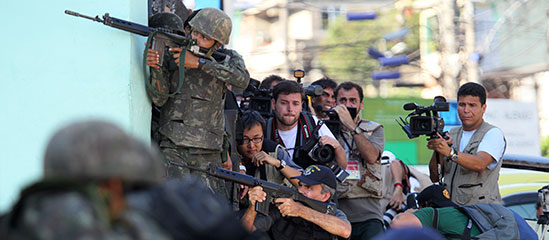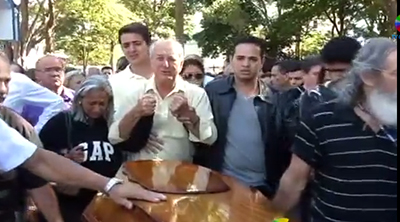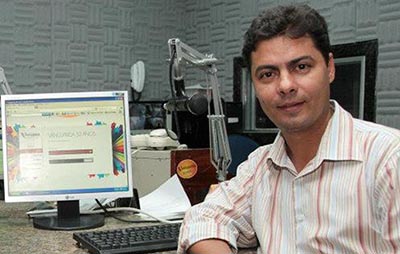2. The vicious cycle of impunity
By Sara Rafsky
When the World Cup kicks off in Brazil in June, the government of President Dilma Rousseff will be celebrating the country’s emergence as a global powerhouse. The event, to be staged at sites across the country, will put the nation’s vast and diverse territory on display, unlike the Olympics, which Brazil is hosting two years later in just one city, Rio de Janeiro. While the 2012 murder of a local soccer journalist in central-western Goiânia may run counter to the official narrative of success, it reflects the disparate realities of a country as immense as Brazil, and depicts a darker side of “the beautiful game.”

Valério Luiz de Oliveira, the second generation in a family of prominent sports journalists, was known for his critical commentary on his television and radio programs on PUC-TV and Rádio Jornal 820 AM. He was particularly unsparing in his condemnation of the managers of the local soccer team Atlético Goianiense, which had recently lost the state championship. He compared them to rats abandoning a sinking ship. Luiz did not shy from criticizing the powerful team vice president, Maurício Borges Sampaio, a wealthy businessman, despite Sampaio’s banning him from the team’s headquarters and attempting to have him removed from his job, Luiz’s son, Valério Luiz de Oliveira Jr., told CPJ. On July 5, 2012, a gunman on a motorcycle shot Luiz, 49, six times outside his offices at Rádio Jornal.
HALFTIME FOR THE
BRAZILIAN PRESS
• Table of Contents
In print
• Download the pdf
In other languages
• Português
In February 2013, the authorities arrested five men and charged them with planning, assisting, and carrying out the murder. Among them was a sergeant from the military police, accused of organizing the crime, and Sampaio, who was charged as the mastermind. All of the men deny the charges, Luiz Jr. told CPJ. (One man charged as an accomplice, Marcus Vinicius Pereira Xavier, confessed and implicated the others, but later disavowed the confession, according to news reports. In late March 2014, Vinicius fled to Europe and is considered a fugitive. The rest of the men are free pending trial.)
Luiz’s case is in many ways exemplary of justice in Brazil: halting and incomplete. Human rights abuses and press freedom restrictions were at the forefront of discussions of recent Olympic Games in China and Russia, but many in the international community might be surprised to learn that Brazil is the 11th deadliest country in the world for journalists since 1992, ranking one spot worse than war-torn Afghanistan, according to CPJ research. At least 10 journalists have been murdered in direct reprisal for their work since Rousseff came to power at the start of 2011, while five others were murdered in unclear circumstances. As the violence has increased, so too has the country’s impunity crisis, with Brazil ranked for four consecutive years on CPJ’s index of nations where the murders of journalists are most likely to go unpunished.
The wave of deadly violence has hit provincial journalists much more than their colleagues in major urban centers, a circumstance that may have made the killings easier to ignore. Despite the troubling statistics, the government initially appeared not to acknowledge the problem. In 2012, Brazilian officials, along with officials from other countries with high impunity rates, raised objections to a United Nations plan that would strengthen international efforts to combat journalist murders and impunity. But under pressure from press freedom advocates, the government backtracked, and the U.N. Plan of Action for Security of Journalists and the Issue of Impunity was adopted. Later, after widespread press freedom abuses during countrywide protests made journalists’ safety an issue of national debate, the wheels of justice began their slow grind.
Since August, convictions have been obtained in four journalists’ murders, an achievement unheard of in the other countries that appear with Brazil on CPJ’s Impunity Index. The reasons for this sudden burst of justice are unclear. Marcelo Moreira, editor-in-chief of RJTV, the local television news station of TV Globo in Rio de Janeiro, told CPJ that the advocacy of media organizations and press freedom groups like the Association of Brazilian Investigative Journalism might have prompted national media outlets to finally cover an issue they had long considered provincial, in turn pressuring the authorities.
Another explanation might be Rousseff’s desire to improve the country’s international image before the World Cup and Olympic Games, or to curry favor with the local press before the October presidential elections. Whatever the reason, the flurry of convictions, combined with the proposed protection mechanism and federal jurisdiction in journalists’ murders under debate in the national congress, demonstrate that this is a government that “understands that Brazil is a dangerous place for a journalist to work, when previously they denied it,” Moreira, a former president of the investigative journalism association, told CPJ.

Heloisa Marques Gimenez, an adviser in the Ministry of Justice, denied that this concern was anything new for the government. “We are closely watching the issue,” she said, “and we are handling it with all the means available to us.”
Marques and Sérgio de Carvalho Alli, an adviser in the press office of the executive branch, both pointed to new initiatives under discussion in various branches of government and the working group that investigated attacks on the press as examples of the policies that officials are seeking to improve the environment for journalists. However, Tássia Rabelo, an official with the Human Rights Ministry, said creation of the working group in late 2012 was not only a show of commitment but also a “recognition of the problem by the Brazilian government, which previously considered the vast majority of deaths of journalists recorded in Brazil to have no direct relation to their exercise of the profession.”
A closer inspection of some of these cases, however, reflects the unique challenges of attaining justice in Brazilian journalists’ murders. Unlike countries such as Mexico or Honduras, where these crimes usually are barely even investigated—no evidence, no arrests, no explanations—the authorities in Brazil often come tantalizingly close to solving the murders, only to see cases evaporate just before the final reckoning. In only one of the four recent cases were all involved parties, including the mastermind, brought to justice. The resolution of that case—the 2002 murder of Domingos Sávio Brandão Lima Júnior, owner, publisher, and columnist of the daily Folha do Estado in Cuiabá, in the central-western state of Mato Grosso—was by no means swift. It wasn’t until October 2013, 11 years after the crime, that a police officer-turned-businessman, João Arcanjo Ribeiro, was convicted of ordering Brandão’s death in retaliation for the journalist’s reporting on his criminal activities.
The other recent convictions snared only the triggermen. The cases of Edinaldo Filgueira and Décio Sá hold many parallels. As with almost all the recent journalist murders, both lived far from the country’s main urban centers. Both maintained careers in traditional print media, while using the freedom of the blogosphere to air their most serious allegations of local political corruption and criminal activity. Filgueira, the founder and director of the local newspaper Jornal o Serrano in northeastern Serra do Mel, had recently published a critical poll on the performance of the local government on his blog when he was shot six times by three unidentified men outside his office on June 15, 2011.
In December 2013, seven men were convicted of planning and participating in the crime, including the gunman, and received sentences ranging from 19 to 23 years in prison. One of the men, who is considered a fugitive, was sentenced in absentia. Josivan Bibiano, who was mayor of Serro do Mel at the time of Filgueira’s death, was charged with being the mastermind of the crime. After being jailed twice, however, Bibiano was released in a decision that critics alleged to be irregular, and it was unclear if he would ever face a trial, local journalists and representatives of the Association of Brazilian Investigative Journalism told CPJ.
A blog set up in remembrance of Filgueira reported that Bibiano is the cousin of three of the convicted men. In a troubling development, Marcos José de Oliveira Ferreira, a cousin of Filgueira who had traveled to Serro do Mel from São Paulo to participate in the sentencing hearing, was murdered the day after the convictions by unidentified gunmen. No motive has been established, but the authorities have not ruled out a connection to the blogger’s case, according to news reports.
Marcos Victor, a lifelong friend of Filgueira and a contributor to Jornal O Serrano, told CPJ that he had nothing but praise for the work of the authorities investigating the crime. He lauded in particular the designation of a special investigator and the involvement of federal law enforcement, but said the chains of accountability broke down once the case reached the judicial branch. Victor told CPJ, “Considering the degree of corruption that exists in the Brazilian courts, I can say that justice will not be achieved in this case.” (Luiz’s son expressed the same sentiment, telling CPJ, “The problem is with the judiciary.”) Both men said they are in favor of federal authorities’ taking jurisdiction of the cases.
Sá was a veteran political reporter for the local newspaper O Estado do Maranhão in the northern city of São Luisand wrote about politicians and corruption on his blog, Blog do Décio, which was one of the most widely read in the state. On April 23, 2012, an assailant walked into the bar where Sá was seated and shot him at least three times at close range.
In the months after the attack, the authorities arrested at least nine suspects who they said were accomplices and plotters and were linked to a loansharking ring that Sá, on his blog, had tied to a local murder. The suspects included a local businessman, Gláucio Alencar, charged with being the leader of the ring and of ordering Sá’s murder, and a deputy chief of police, both of whom denied the charges, according to news reports. In February 2014, two other men, including the confessed gunmen, were sentenced to jail terms ranging from 18 to 25 years in prison. The other men are still awaiting trial.
While many bloggers in Brazil toil in relative obscurity, Sá was one of the best-known journalists in the state and had powerful backers. Though São Luis is on the far north coast of Brazil in a state that is often considered something of a Wild West, O Estado do Maranhão is owned by the Sarneys, one of Brazil’s most prominent political families. José Sarney, a former president of Brazil and then president of the Senate, called the crime “an attack on democracy.”
A marked contrast to the relatively rapid investigation and trial in Sá’s case is the lack of progress in the case of the far less prominent blogger Mario Randolfo Marques Lopes, whose body was found along with that of his companion in Rio de Janeiro state two and a half months before Sá’s murder. Marques had also written about local political corruption and alleged police involvement in criminal activity. The only significant development in the investigation more than two years since his murder was the decision to exhume the blogger’s body in February 2013, to compare his DNA samples with blood found in a car, according to news reports. There has been no explanation or public update in the case since.
In other cases, such as those of Mafaldo Bezerra Goes and Luciano Leitão Pedrosa, arrests have been made and prosecutions continue.
If anything can be learned from the erratic nature of the Brazilian justice system, it is that the most powerful force for combatting impunity is often the press corps itself. Victor, who founded the Edinaldo Filgueira Institute to promote freedom of expression in the region, said the convictions in the Filgueira case would never have been achieved without the mobilization of the local community of bloggers, who put together a conference where they commemorated Filgueira as a patron of all bloggers, and established a National Bloggers’ Day in his honor to keep the case in the public eye.
Luiz’s 25-year old son established the Valério Luíz Institute, which is seeking justice for his father’s murder and has joined forces with other local press organization to fight for press freedom and the protection of journalists. The institute has organized public hearings, created social media campaigns, and sent local soccer teams onto the field wearing T-shirts bearing a stark black and white portrait of Luiz. The journalist’s son is also advocating federal jurisdiction in his father’s case and federal protection mechanisms for journalists at risk.
“Would they have pulled the trigger if the Goiânia press was united, cohesive and strong?” Luíz Jr. wrote in a statement. “After the accused are convicted, any colonel will think twice before picking up a rifle because of a microphone.”

A similar form of grass-roots mobilization was used by the Vale do Aço press corps in Minas Gerais State last year. After journalist Rodrigo Neto and photographer Walgney Assis Carvalho of the dailyJornal Vale do Aço were murdered in a period of weeks, a group of local reporters founded the Rodrigo Neto Committee to investigate the killings, including suspected police involvement, and to continue the work the journalists left behind. The committee was formed to “demonstrate to society that the press is united and we will not disband until we get an answer for this crime. We’re mirroring the work that Rodrigo himself did: conducting research and always remembering, as a way to combat impunity,” one of the committee’s founders, Anna Sylvia Rodrigues, said at the time.
A year later, several police officers are in prison on charges of participating in the crime, but no mastermind has been identified and the exact motive remains unexplained, according to news reports. After continuously pressuring the authorities in the first months after the murders, the committee’s public actions appeared to slow after the first wave of charges were filed in mid-2013, according to a review of the committee’s website and social media accounts. In a public message posted to the group’s Facebook page in the fall of 2013, a spokesman wrote: “The Rodrigo Neto Committee is not finished. Journalists and media professionals are following the hearings …[but] the situation is tense. There has been no lull … the threats to professionals continue.” CPJ’s requests for comment from the committee went unanswered.
Precedents for organized professional solidarity campaigns in the wake of journalists’ murders exist across the region—which benefits from a historically strong civil society—from the Manizales project in Colombia to the Chauncey Bailey Project in the United States. By contrast, isolation and a lack of solidarity in countries such as El Salvador and Honduras compound risk and can make a dangerous place even more deadly for the press, CPJ research has shown. In Mexico, lethal violence and threats by organized crime have terrorized the media into silence. Thus, a recent national movement to demand justice in the murder of journalist Gregorio Jiménez de la Cruz in Veracruz was an unprecedented, and hopeful, development.
The Neto and Carvalho cases exemplify the best and the worst of the state of impunity and journalists’ murders in Brazil: Outside the national media glare of São Paulo and Rio de Janeiro, two journalists were murdered in circumstances that implicate criminal elements within the police force. The local press corps mobilized to demand justice, the investigations progressed, and alleged accomplices and gunmen were placed in custody and charged. Despite these advances, if the story ends there, the Brazilian press is not out of danger. Victor told CPJ that the lack of total resolution in Filgueira’s murder has created a general sense of fear in Serra do Mel, which has resulted in several journalists’ fleeing the area and losing their livelihoods. Luíz told CPJ that self-censorship is now widespread in Goiânia, and that he suspects the local press is waiting to see what happens with the case against the accused mastermind Sampaio. “If we really want threats to stop,” Moreira told CPJ, “we have to get the big guys.”
The 10 journalist murders in the past three years reflect the difficulty of netting “the big guys.” But the image of journalists allegedly murdered by rogue criminal elements within the local police forces, and whose cases are tried by courts under the influence of local political and economic interests, is likely not the one the president hopes to promote at the World Cup or the Olympic Games. If Rousseff is serious about combatting anti-press crime, her government will have to undertake painful efforts to root out state and municipal-level corruption, as well as beef up preventative safety measures. But the country is home to a vibrant, talented investigative press corps, which the government seems to be increasingly aware it must protect. Citing the progress of the recent convictions, Moreira told CPJ, “Brazil is a big, young democracy and we are still growing up. This process may be moving slowly, but it won’t stop.”
Sara Rafsky is research associate in CPJ’s Americas program. She wrote CPJ’s 2012 special report on press freedom in Argentina and provided research for the 2013 special report on the Obama administration and the press. Previously a freelance journalist in South America and Southeast Asia, she was awarded a 2008 Fulbright Grant to research photojournalism and the Colombian armed conflict.